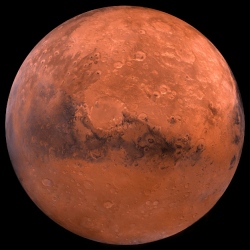
The rocket and car entrepreneur told an audience in Adelaide, Australia, that he would begin building the necessary ships to support the mission next year. He says he is refocusing his SpaceX company to work on just one type of vehicle that could do all of the firm’s current work and interplanetary travel.
Known as the BFR, this rocket system could also carry people rapidly around the Earth from city to city.
"Most of what people consider to be long-distance trips could be completed in less than half-an-hour," he told the International Astronautical Congress.
Mr Musk first laid out his Mars ambitions at the IAC in 2016. Twelve months on, he returned with more detail.
His BFR, although still massive, is now a little smaller at 106m in height and 9m in width.
The major difference compared with the original version, however, was cost, the South African-born American said.
"I think we’ve figured out how to pay for it. This is very important."
The route to affordability, he explained, was in refocusing all of the company’s efforts into the one system – and then using that to meet all its customers’ needs.
This means the BFR would launch satellites and service the space station – as SpaceX’s Falcon 9 and Dragon capsule do now – but also take people to the Moon and Mars, and do what is termed "point to point" travel on Earth where passengers fly, for example, from New York to Shanghai in something like 40 minutes.
"Some of our customers are conservative and they want to see the BFR fly several times before they’re comfortable launching [on it]," Mr Musk said. "So what we plan to do is to build ahead and have a stock of Falcon 9 and Dragon vehicles, so that customers can be comfortable if they want to use the old rocket, the old spacecraft – they can do that because we’ll have a bunch in stock.
"But all of our resources will then turn to building BFR."
As well as being the CEO and chief designer at SpaceX, Mr Musk also founded the Tesla electric car company and is chairman of SolarCity which specialises in renewables technologies, such as high-storage batteries.
He has attracted a rock-star following from fans who love his visionary thinking. And although his promises have often taken much longer to deliver, he has achieved a number of notable firsts.
These include landing 16 orbital-class rockets back on Earth after they have completed their missions. Two of these rockets have even flown a second time.
Key to his thinking is the concept of reusability. Space activity is currently expensive only because it is disposable, he says. There is no reason, he claims, why rocket systems cannot be made to operate like airliners where the most significant ongoing cost is the fuel in the tanks.
His Falcon 9 rocket is partially reusable; the BFR would be totally reusable. The same vehicle would fly time and time again.
Mr Musk recognises that his ambitious timelines sometimes slip. When he put up a slide in Adelaide stating that the first cargo (no humans aboard) versions of BFR would go to Mars in 2022, he said: "That’s not a typo, although it is aspirational."
His many fans in the audience lapped up the presentation, but his numerous business customers will also have stiffened slightly at the news that SpaceX is to begin diverting its energies towards an all new rocket system.
These customers are extremely conservative – as Mr Musk himself conceded. They are only just beginning to grapple with the idea that they can put their very expensive satellites on "second-hand" Falcons. Now they must also get used to the idea that the Falcon will eventually be replaced by another rocket system – the BFR.
